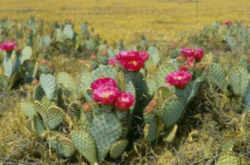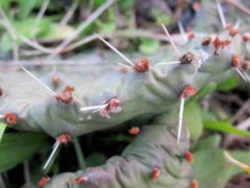
Texas Symbols
- State Resources
- » 50 States
- » Texas
- » Symbols
Texas State Plant
Prickly Pear Cactus

(genus Opuntia)
Adopted on May 25, 1995.
The Prickly Pear was named the state plant when Governor George W. Bush signed House Concurrent Resolution No. 44 on May 25, 1995. The Prickly Pear is of the Opuntia genus with many different species native to Texas. While it isn't a towering behemoth with a man-like appearance, the Prickly Pear is still a distinctive and lovely plant in its own right.
Texas State Plant: Prickly Pear Cactus

Few plants are as loved and hated as the prickly pear cactus. It's numerous thorns, both large and small, have made the acquaintance of anyone who has strolled through any open country in Texas. The other side of the coin is their beautiful flowers, their use as food (minus the thorns and cut in strips they taste like green beans), their soil retention and their use as emergency food for cattle (again minus the thorns).
It may not look like it, but the early Desert Indians used this for food. They ate the fruit that grew on the prickly pear, and they scraped the needles off and ate the cactus.
Once a well kept secret, this rare fruit is grown on the leaves of the prickly pear cactus. Renewed interest in regional cuisine has prompted a surge in popularity for the up and coming culinary star. A mainstay in Mexican and Southwestern cooking, new twists on traditional favorites like cactus fruit jelly or bright fuchsia-colored prickly pear margaritas as well as innovative signature applications like prickly pear vinaigrette, barbecue sauce, sorbet and semifreddo have whetted the US appetite.
Prickly pear cactus represent about a dozen species of the Opuntia genus (Family Cactaceae.) All these cacti have flat, fleshy pads that look like large leaves. The pads are actually modified branches or stems that serve several functions: water storage, photosynthesis and flower production.
Members of the Opuntia genus are unique because of their their clusters of fine, tiny, barbed spines called glochids. Found just above the cluster
of regular spines, glochids are yellow or red in color and detach easily from the pads. Glochids are often difficult to see and more difficult to remove,
once lodged in the skin.
The fruits of most prickly pears are edible and sold in stores under the name "tuna." Prickly pear pads are also cooked and eaten as a vegetable. They,
too, are sold in stores under the name "Nopalito."
Description
Most prickly pear cactus have yellow, red or purple flowers, even among the same species. They vary in height from less than a foot (Plains, Hedgehog,
Tuberous) to 6 or 7 feet (Texas, Santa Rita, Pancake). Pads can vary in width, length, shape and color. The Beavertail, Santa Rita and Blind Pear are
regarded as spineless, but all have glochids.
In addition to the North American native prickly pear cactus listed below, there are many varieties, non-native imports and hybrids, so identification
can often be difficult. Information on the 15 species below is based on wild, non-cultivated samples.
Other names
It is also called cactus pear and Indian fig - "Figadindi" in Italian. The pads are "cladodes" or "nopales" when they're whole, and "nopalitos" when they're diced. The fruits are called prickly pears, cactus pears, or "tunas".
Range & Habitat
Prickly pear cactus are found in all of the deserts of the American Southwest, with different species having adapted to different locale and elevation ranges. The prickly pear is tolerant of varied soils, temperatures, and moisture levels. The plants grow best in a sunny position in well-drained sandy loam with some protection from cold winter winds. Plants benefit from applications of a balanced fertilizer during their spring-through-fall growing period and, with excellent drainage, can tolerate almost as much water as any other cultivated plant. They are, however, drought tolerant once established.
Texas Concurrent Resolution No. 44
Texas CONCURRENT RESOLUTION 44
By Raymond H.C.R. No. 44
74R2690 BNL-D
CONCURRENT RESOLUTION
WHEREAS, The State of Texas has traditionally recognized certain terrestrial forms indigenous to the state as official state symbols; and
WHEREAS, The bluebonnet, the pecan tree, and the mockingbird are examples of some natural specimens that serve to symbolize the rich diversity of the
plains, forests, skies, and mountains of our vast state; and
WHEREAS, In keeping with this custom, the designation of the prickly pear cactus as the official state plant will provide suitable recognition for
this hearty and beautiful denizen of the Texas landscape; and
WHEREAS, A native of the American Southwest and the Sonoran Desert region of Mexico, the prickly pear cactus provided nourishment to the earliest inhabitants
of those regions, and both the sweet, fleshy fruit and the broad, flat stems were incorporated into tasty dishes; and
WHEREAS, Tunas, the prickly pear fruit, and nopales, which are made from the stem, have since become staples of the Mexican diet, and their growing
popularity in Lone Star cuisine can be attributed to Texans' appreciation for unusual and distinctive foods; and
WHEREAS, In recent years, the prickly pear cactus has been successfully exported and naturalized to tropical areas around the world, and it has proven
to be a popular landscape choice for all who want to have a little bit of Texas in their own backyards; and
WHEREAS, This adaptable plant can survive under many different environmental conditions, and thus can be found from the hill country of Central Texas
to the windswept plateaus and arid mountains of West Texas; because it thrives in a harsh climate that few plants can bear, the prickly pear cactus
is often grown as forage for cattle and has had a tremendous positive impact on the vital Texas cattle industry; and
WHEREAS, Rugged, versatile, and uniquely beautiful, the prickly pear cactus has made numerous contributions to the landscape, cuisine, and character
of the Lone Star State, and thus it is singularly qualified to represent the indomitable and proud Texas spirit as an official state symbol; now, therefore,
be it
RESOLVED, That the 74th Legislature of the State of Texas hereby designate the prickly pear cactus as the official state plant of Texas.
House Concurrent Resolution No. 44, 74th Legislature, Regular Session (1995)
Texas Law
The prickly pear cactus was named the official state plant of Texas by House Concurrent Resolution and is not, therefore, listed in the Texas Statutes.







